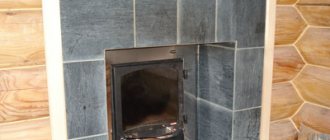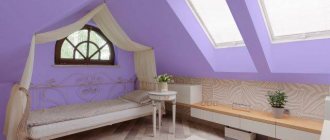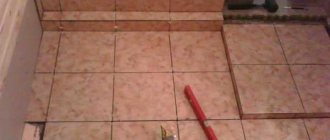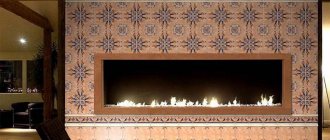To equip heating structures, fireproof sheet materials for fireplaces and stoves are also needed, since combustion devices heat up to high temperatures during operation.
Only then are they able to transfer heat to the surrounding space. At the same time, surfaces are heated, especially walls that are located closest to the stove or fireplace. And to avoid fire, screens and cladding are also made from such composites, which should also have an aesthetic appearance.
Fire-resistant sheet materials for stove and fireplace protective screens
Protective screens made of steel sheets are mostly used for metal combustion products to insulate their side walls. They are installed at a distance of up to 5 cm from the walls of the heating device and reduce thermal radiation.
Screens can be side or front. With their help, the temperature on the outer surfaces of combustion systems is reduced to +100 °C, which improves fire safety. Installation of convenient protective screens is simple and is carried out by attaching them to the floor using special legs.
Side protective screen [ads-mob-1][ads-pc-1]
Classification
Fire-resistant products are available in various forms: in plates, sheets, rolls and there is a group of unformatted materials. In addition, it is divided into types according to other characteristics:
By size and shape:
- wedges and straights of small, normal and large sizes;
- shaped simple, large-block, complex, weighing more than 60 kilograms;
- laboratory or industrial use.
By production method:
- production of refractory materials by sawing rocks from blanks;
- cast, made using liquid casting technology;
- production from plastic masses with subsequent additional pressing;
- formatting by pressing from powders;
- made by hot pressing;
- manufactured by thermoplastic pressing;
- formatted from hot melt.
According to deformation temperatures:
- from 1580 degrees C to 1770 degrees C - ordinary fireproof;
- up to 2 thousand degrees C – highly fire-resistant;
- up to 3 thousand degrees C – materials with the highest fire resistance;
- more than 3 thousand degrees C – super-fire-resistant.
By degree of porosity:
- the pores are open, their volume does not exceed 3% - especially dense;
- pores open up to 10% - highly dense;
- pores are open, volume up to 16% is dense;
- pores are open, up to 20% are compacted;
- pores are open, up to 30% - medium dense;
- total porosity up to 45% - low density;
- total porosity up to 75% - highly porous;
- total porosity more than 75% - ultra-porous.
Varieties by composition:
- oxygen-free;
- siliceous;
- silicon carbide;
- aluminosilicate;
- carbon oxides;
- glass-magnesite;
- aluminous;
- carbon;
- magnesium;
- oxide;
- magnesian-calcareous;
- zirconium;
- limestone;
- chromium;
- magnesia-silicate.
Basalt fireproof insulator
Reflective trim
It is effective to use cladding consisting of fire-resistant sheets in combination with non-flammable thermal insulation composites.
Fire-resistant sheet materials are mounted on top of thermal insulation; it is preferable to use stainless steel sheets for such cladding, since galvanized steel sheets can release toxic substances into the air when heated. To make the protection more effective, the steel sheet is polished to a mirror finish: this way, heat rays are reflected better from the metal, and the wall heats up even less.
Wall cladding with mineralite slabs
There is a whole range of OLM for cladding:
- basalt cardboard, made of basalt fiber, provides good heat and sound insulation;
- asbestos cardboard is durable and strong;
- mineralite; protective screens for stoves and fireplaces are also made from its sheets.
Fireproof fender board
A universal solution for protecting the walls of any building can be considered the use of fire-resistant fender boards, which have high performance advantages. It is based on a non-flammable panel covered with HPL plastic, which is difficult to burn. The edges of the panel are treated with a special edge. In addition to its protective function, it is also characterized by excellent decorative properties, so it can decorate any room. high performance indicators, the Impact Board is used in places with high traffic volumes: in kindergartens and schools, hospitals and clinics, train stations and cinemas, supermarkets. This material is environmentally friendly and moisture resistant, hygienic and safe, as well as aesthetically pleasing. The bumper board is available in different colors and sizes.
Cladding with cladding
Facing the mineralite surface with soapstone tiles.
For this, the following fire-resistant sheet materials are taken:
- fire-resistant plasterboard - it is made with the addition of fiberglass and does not deform under the influence of thermal radiation;
- mineralite, it is also characterized by high moisture resistance and the ability not to collapse under the influence of elevated temperatures;
- The glass-magnesium sheet is made of fiberglass (in which the magnesium substance acts as a binder), it is able to withstand high temperatures.
Heat-resistant screens for sauna stoves. Part 2
Technical and operational characteristics
The main property of such materials is fire resistance, which expresses the temperature at which the deformation process begins. With respect to this value, the effectiveness of their use for certain purposes is considered. In addition to this parameter, others are also considered. Namely, how refractory behaves under the influence of strong heat:
- change in shape and violation of the integrity of the product under load at elevated temperatures;
- compression force parameters when heated, they reflect the stability of the structure;
- Neutral to chemical influences.
On a note! Fire-resistant materials can withstand significant temperatures, the minimum value is +1580 degrees C, the maximum is 3 thousand degrees C. Products that can maintain properties at the highest temperature parameters are called super-fire-resistant.
Fireproof cardboard MKRKL
Wall cladding with sheet fire-resistant material
To ensure the fireproof condition of the room, you need to wisely select the material for covering the walls near which the heating structure is located.
And vermiculite panels are ranked among the most effective OLM. Moreover, such slabs are used to ensure fire safety in various premises, including enterprises in the nuclear and oil refining industries.
Among the advantages of fire-resistant vermiculite boards are:
Vermiculite boards
- environmental friendliness;
- fire resistance;
- thermal insulation;
- sound insulation;
- aesthetic appearance, which allows them to be used in prominent places.
Where are they used?
Vermiculite panels, due to their excellent performance qualities, can be used in many areas.
Scheme of thermal protection of a wall and fireplace lining with a vermiculite slab
- For thermal insulation of fireplaces and stoves.
- For fire protection of structures made of different materials.
- To ensure that various objects can withstand fire hazards.
- For guaranteed fire resistance of various indoor items, including stoves and fireplaces.
Vermiculite boards, as representatives of OLM, are installed simply and quickly and do not require professional training. Processing them on all sides of a stove or fireplace ensures protection of the room from the effects of fire and high temperatures, and therefore such fire-resistant sheet materials are optimal in solving the problem associated with the fire safety of the room.
All samples of fire-resistant sheet materials for stoves and fireplaces are modern, high-quality products. In addition to fire protection, they provide heating devices with resistance to various types of damage, including mechanical and chemical.
[ads-pc-2][ads-mob-2]
Decorative wall panels FIREPROTEC HPL
Decorative wall panels FIREPROTEC HPL, which are characterized by fire resistance, are produced on the basis of high-quality non-combustible FIREPROTEC SML Premium Standard panel or GSP (gypsum particle board). HPL panels for indoor use are used in kindergartens and schools, offices and many other premises to create a comfortable and cozy atmosphere.
Fire retardant materials.
A fire can be a major and unexpected disaster for every home owner, leading to the destruction of their property and valuables. Causing a threat to the life and health of all households. Fire is a terrible element that is extremely difficult to combat. That is why such a tragedy must be prevented so that there is no need to eliminate its consequences later. Protecting your home from fire is a necessity for a safe life for everyone. The most affordable and reliable way to protect yourself and your loved ones is to buy reliable fire-retardant materials necessary to increase the time it takes to reach the critical temperature in a fire.
SML panels
These magnesite glass sheets are made from magnesium oxide with special additives. Double glass fiber reinforcement imparts rigidity to the sheets.
The operational qualities of LSU are similar to those of SCL. But LSU sheets are tougher and especially durable. This material is most used in places that require increased strength: they are in demand for the manufacture of billboards, roofing and floors.
Like SKL sheets, they are aesthetically pleasing and have antiseptic properties.
the high strength of the panels allows them to be used for reinforcing and finishing foam and aerated concrete, facades, as well as sandwich panels.
Solid fuel stove: fire protection rules
It seems that one thing in the world will remain unchanged, even when everything in it changes: people will light the stoves. Neither electricity nor gas will be able to displace solid fuel stoves from our homes. Based on the experience of FORUMHOUSE users, today we will talk about fire protection of rooms in which a solid fuel stove is used.
Wood-burning stoves and fireplaces are real symbols of home comfort: firewood crackles in the firebox, soft warmth spreads throughout the house... But if you do not think through fire protection or frivolously save on it, the stove can become a source of danger to property and life. A fire can start due to one spark falling from the firebox, or an overheated wall. When we install a stove or fireplace, fire protection should be an “extremely important expense” and should not be skimped on under any circumstances.
Archi73FORUMHOUSE Member
I assure you that life is more expensive.
Therefore, conscientious manufacturers of stoves and fireplaces always write in their instructions that protection of the floor, walls and ceiling is necessary at the place where heating devices are installed.
Screen
To reduce the thermal radiation of a metal heating device, protective screens are made from sheets of cast iron or steel. The screen lowers the temperature of the hot stove to +100 degrees. The finished screen can be easily mounted at a distance of up to 50 mm to the stove wall.
Floor
The floor on which the TT stove is installed must be protected with a non-flammable and durable coating. Options for the base on which the stove is installed can be as follows:
Alexey TeleginForumHouse Member
- on asbestos cardboard 5 mm galvanized sheet;
- or over two layers of GVL - porcelain stoneware;
- stainless steel, etc.
How to determine the size of this fire retardant floor pad? Usually it is made so that on each side it protrudes 100 millimeters beyond the perimeter of the oven. A pre-furnace sheet must be installed in front of the stove, which will protect against sparks and embers falling out of the firebox. Depending on the size of the firebox, the size of the sheet can be small, 500x700 mm, or 400x640 mm, or protrude 100 mm beyond the firebox from the other side.
Nowadays, rarely does anyone make sheets the old fashioned way, by nailing a piece of tin to the floor. More often they buy ready-made beautiful sheets of polished stainless steel, and for the fireplace - copper or brass, decorated with artistic etching and patina.
The stove must be at least 100 millimeters from the floor.
Ceiling
For fire protection of the ceiling, you can use the same materials as for the floor, only the distances to the heating device change.
If we are talking about a stone stove (smoke exhaust pipe and the top of a heat-intensive stove, covered with three rows of masonry), then the ceiling should be at least 250 millimeters from the surface of the stove. If we are talking about a non-insulated metal stove (as most bathhouses are), then the minimum distance is 1200 millimeters. If the ceiling is protected and the stove has thermal insulation, then the distance is reduced to 800 mm.
The fire protection on the ceiling should be larger than the perimeter of the heating device - add 150 millimeters on each side to the perimeter of the stove surface.
Walls
For optimal fire protection, the solid fuel stove is placed at a safe distance from the wall, which must be protected from fire. The material and method of protecting the walls depends on the thickness of the furnace walls. Members of our portal use fire retardant impregnations, mastics, foaming compounds, etc. to treat walls. This type of fire protection requires frequent updating. But what is more in demand among FORUMHOUSE users is not surface treatment compounds, but materials for their protection: basalt fiber mats, foil fire protection, etc.
Fire-resistant boards are especially popular: vermiculite, supersil (thin boards designed for use in the defense industry and withstanding temperatures above + 1000 degrees), fiber cement panel, glass-magnesite sheet, gypsum fiber sheet (GVL), calcium silicate (superizol). Not all of these materials are equally good, but they can withstand long-term heating to high temperatures, conduct heat poorly and last a long time without losing strength.
And in bathhouses, some still use the old ancestral method: they decorate the walls with two layers of felt soaked in a clay solution.
Alexey Telegin
Such protection not only prevents fire, but also signals the danger of fire with the smell of a burnt feather.
Options and combinations
Most of these materials and methods can only be used under certain conditions, combining them with each other and observing a number of requirements. For example, we trim the walls with slabs of fire-retardant material of a certain thickness, and we install a protective screen on a metal stove, etc.
Here are the options for protecting walls that are used by members of our portal (in both cases, the stoves are located in the country, the walls are clapboard):
— The wall is treated with a fire retardant compound, an asbestos sheet (or similar) is installed on top, from the ceiling to the floor, and on the sides of the stove it protrudes 15 centimeters. On top is a sheet of plasterboard, and the “pie” is completed - tiles for beauty.
— Two layers of basalt cardboard are applied to the lining in a checkerboard pattern, with an overlap; mineralite is placed closely on it, and a roofing profiled sheet with a round cross-section is placed on it. The subtlety is that the sheet should have a gap of 5 centimeters from the floor for convention.
The combination of several methods of wall insulation makes the protection reliable. And vice versa.
RedstonFORUMHOUSE user
85% of fires occur precisely when several factors, individually, in general, are quite acceptable, come together at one point.
Redston gives the following example: according to flammability, flammable building materials are divided into groups, and, in particular, group B1 includes those that are difficult to ignite, for example, gypsum fiber board, which many use for fire protection.
Redston
Flammability group B1 means that you need to apply a power of 35 kW or more per square meter of surface. But the area of your stove is much smaller, and iron stoves sometimes get very hot. To ignite a piece of GVL with an area of 10x10 cm, you need only 350 watts! GVL has low thermal conductivity, which means that local heating will not be dissipated over its area. It will heat up at one point, and go!
The distance between the stove and the wall depends, first of all, on the type of stove. You need to keep in mind that no matter how you protect the walls, for metal stoves the distance must always be set with a margin..
Alexey Telegin
When standards are neglected or excessive reliance is placed on thermal insulation, fire occurs.
The distance between the wall and the outer surface of the stove is called a setback in the professional language of stove makers. It is a correctly made retreat that protects the wall from an accidental spark that can fall out of the door gap, and from overheating, which leads to ignition.
The table presented at FORUMHOUSE by Alexey Telegin shows the minimum permissible distances between the stove and the wall.
| Furnace wall thickness, mm | Retreat | Distance from the outer surface of the stove or smoke duct (pipe) to the wall (partition), mm | |
| not protected | protected | ||
| 120 | Open | 260 | 200 |
| 120 | Closed | 320 | 260 |
| 65 | Open | 320 | 260 |
| 65 | Closed | 500 | 380 |
If the oven is thin-walled and the wall surface is not protected, the distance should be 500 mm. If the stove is thick-walled, and you have protected the wall to the maximum, a distance of even 200 mm is allowed.
With an open setback, there is open space on all sides of the oven.
A closed setback is a structure that is closed on all or more sides. How it works can be understood from the figure below.
1. Furnace foundation. 2. Sealing layer. 3. Fireproof floor. 4. Wooden wall. 5. Shield made of boards. 6. Thermal insulation (asbestos or felt). 7. Brick “on edge”. 8. Oven. 9. Pre-furnace sheet.
If the stove (or chimney) “crashes” into some partitions - this, for example, often happens in a bathhouse, when the stove itself is in the steam room, and the firebox door is in another room, a retreat is also made between the stove and the partitions. The less protected the structures are, the greater this distance should be.
FORUMHOUSE member Kisha has a big old house. He wants to divide it into two rooms, and put a stove where the frame partitions intersect. Members of our portal advised him to lay out a brick-wide indentation right from the stove, and then attach partitions to it. It is even better if fireproof materials are included in the structure of the partitions.
Dmitry2791FORUMHOUSE member
For example, a metal profile with SML on it, flat slate, mineralite, etc. For sound insulation, fill the adjacent to the stove with basalt cardboard or basalt wool and disguise it with a metal threshold.
In general, when installing a stove or fireplace, it is recommended to carefully study the manufacturer’s instructions, which usually indicate both the amount of deviation and the recommended operating modes. If the distances are not indicated in the instructions, you need to study the SNiP, the link to which is provided by the certificate of conformity. Most often, the size of the indentations is given there, and even depending on the operating mode that you choose.
At FORUMHOUSE you can ask your questions to the stove maker and get professional advice on the rules and regulations for installing chimneys. Watch the video about a real Russian stove. Read our article, which will be a good help for those who are planning to lay out a fireplace with their own hands.
Fiberboard boards
Fiberboard is a bioresistant board made by pressing wood fiber, so-called wood wool, and a binder of inorganic origin. The fiber used is obtained from waste from woodworking machines. These slabs are lightweight, have good acoustics and are fire resistant: the slab shavings are impregnated with cement and are not in any danger from exposure to fire. The material can be easily attached using self-tapping screws and nails, as well as dowels to any surface. It lends itself well to sawing. Composite fiberboard panels consist of two or three layers, the thermal insulation material of the middle layer made of rigid foam or mineral fiber (mineral silicate wool) can be up to 140 mm thick, at which the degree of thermal and sound insulation increases.
Features of sheet fire protection
This imposes specific requirements for such products, the main of which are:
- High fire resistance and increased heat-shielding properties. The small thickness of the material should not affect its protective qualities, so manufacturers often use foiling or polishing of the metallized surface of sheets for better heat reflection;
- Strength and durability. Typically, materials are installed before the installation of heating equipment, so their repair or replacement is very difficult and expensive. Fire protection sheets withstand mechanical stress well, are not susceptible to chemicals, are resistant to dirt, mold, etc.;
- Ease of processing and installation, good decorative qualities or the possibility of applying finishing;
- Safety for humans - they are most often installed indoors.
In addition, the operation of powerful heating devices is often noisy, so manufacturers pay attention to the soundproofing qualities of their products.











